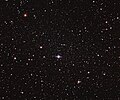Tiedosto:Carina Dwarf Galaxy.jpg
Siirry navigaatioon
Siirry hakuun

Tämän esikatselun koko: 719 × 600 kuvapistettä. Muut resoluutiot: 288 × 240 kuvapistettä | 576 × 480 kuvapistettä | 921 × 768 kuvapistettä | 1 228 × 1 024 kuvapistettä | 2 456 × 2 048 kuvapistettä | 3 771 × 3 145 kuvapistettä.
Alkuperäinen tiedosto (3 771 × 3 145 kuvapistettä, 5,64 MiB, MIME-tyyppi: image/jpeg)
Tiedoston historia
Päiväystä napsauttamalla näet, millainen tiedosto oli kyseisellä hetkellä.
| Päiväys | Pienoiskuva | Koko | Käyttäjä | Kommentti | |
|---|---|---|---|---|---|
| nykyinen | 24. helmikuuta 2015 kello 15.14 |  | 3 771 × 3 145 (5,64 MiB) | FDMS4 | Reverted to version as of 14:03, 28 June 2011. |
| 24. helmikuuta 2015 kello 05.00 |  | 3 768 × 3 144 (5,78 MiB) | SteinsplitterBot | Bot: Image rotated by 180° | |
| 28. kesäkuuta 2011 kello 16.03 |  | 3 771 × 3 145 (5,64 MiB) | Jmencisom |
Tiedoston käyttö
Seuraava sivu käyttää tätä tiedostoa:
Tiedoston järjestelmänlaajuinen käyttö
Seuraavat muut wikit käyttävät tätä tiedostoa:
- Käyttö sivustolla af.wikipedia.org
- Käyttö sivustolla ar.wikipedia.org
- Käyttö sivustolla ast.wikipedia.org
- Käyttö sivustolla ca.wikipedia.org
- Käyttö sivustolla de.wikipedia.org
- Käyttö sivustolla el.wikipedia.org
- Käyttö sivustolla en.wikipedia.org
- Käyttö sivustolla es.wikipedia.org
- Käyttö sivustolla fr.wikipedia.org
- Käyttö sivustolla he.wikipedia.org
- Käyttö sivustolla id.wikipedia.org
- Käyttö sivustolla it.wikipedia.org
- Käyttö sivustolla ja.wikipedia.org
- Käyttö sivustolla ko.wikipedia.org
- Käyttö sivustolla mk.wikipedia.org
- Käyttö sivustolla nl.wikipedia.org
- Käyttö sivustolla no.wikipedia.org
- Käyttö sivustolla pl.wikipedia.org
- Käyttö sivustolla pt.wikipedia.org
- Käyttö sivustolla ro.wikipedia.org
- Käyttö sivustolla ru.wikipedia.org
- Käyttö sivustolla si.wikipedia.org
- Käyttö sivustolla sk.wikipedia.org
- Käyttö sivustolla tr.wikipedia.org
- Käyttö sivustolla uk.wikipedia.org
- Käyttö sivustolla vi.wikipedia.org
- Käyttö sivustolla www.wikidata.org
